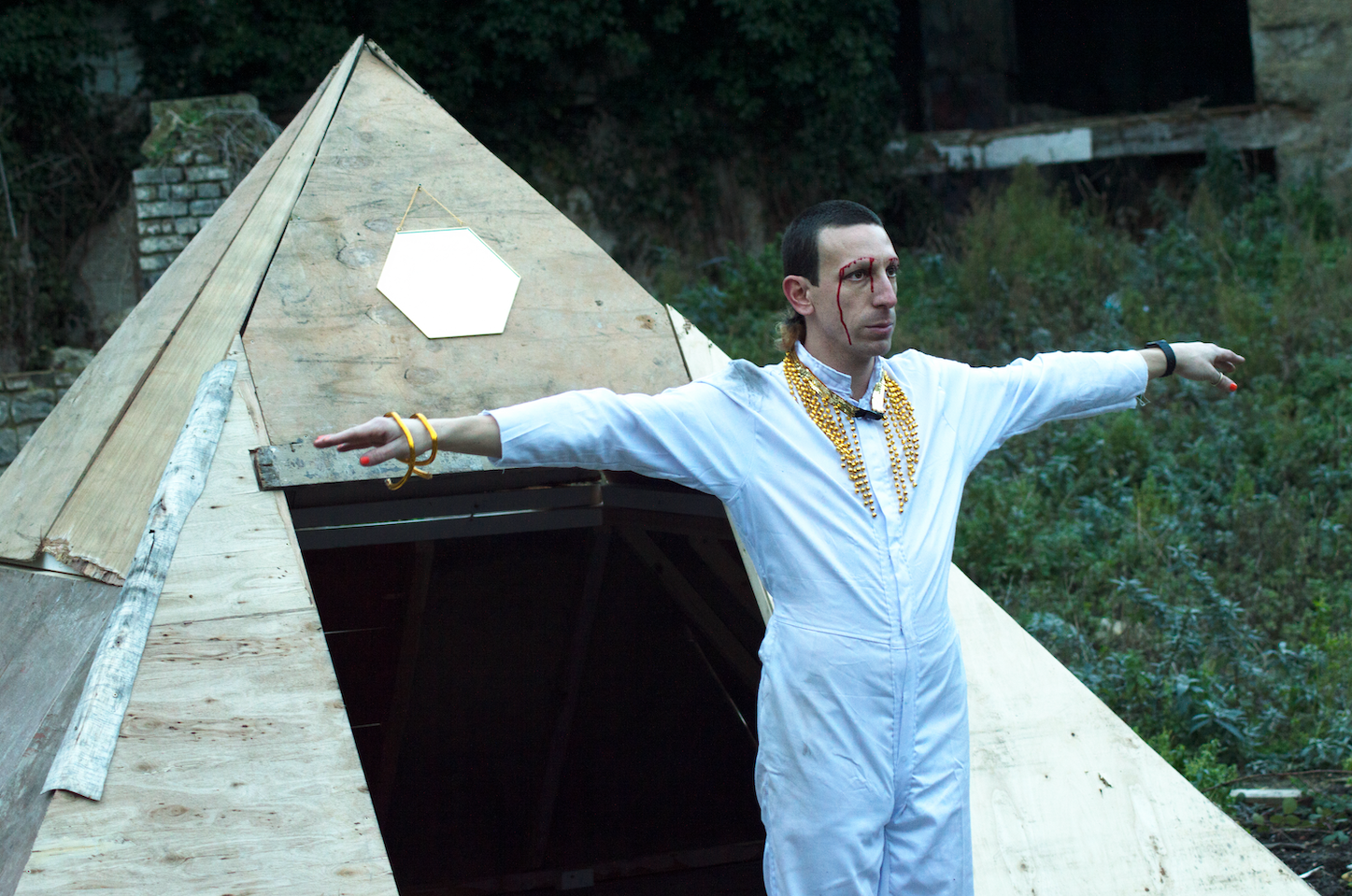Lewis Church
A Pyramid in the Wildnerness
This text is one of several commissioned responses to PAUSE & AFFECT; a series of curated artist-in-residency duos across 2018/19.
︎︎︎ about PAUSE & AFFECT
Gabi, PAUSE&AFFECT, Photo credit pending.
For their showing Gabriele Longega built a pyramid in a derelict lot. Set amongst weeds and crumbling brick, its scrap wood peak looked like a temporary sweat lodge, a birthing tent, liminal hut, isolation pod or a hermit’s shack. It was a structure full of and steeped in ancient imagery and echoes of history, with reeds at the door and birds overhead. Built over the course of a day from materials scavenged from around the town, just down the road from the residency space. It sat within an overgrown and normally fenced-off area of crumbled foundations, where a building once was but the space now stands empty.
Slowly taking shape as Longega worked in the cold, the pyramid provided the stage for a series of ritual actions featuring the charged materials of blood, a mirror and brief snatches of physical movement, visible to the small number of spectators that moved close, over the uneven ground, to peer through the doorway of this new rough hut. There they could see the artist accompanied by a soundtrack of ominous noise, labelling the structure with their own blood on two sheets of paper, daubing the legend ‘third space’ to be displayed on either side of the pyramid entrance. Examining their wounded face in a mirror that was then placed above the door, oriented outward to reflect anyone entering, the artist moved slowly from pose to pose, shivering slightly in the rapidly greying light.
Longega later explained the action within the context of a practice devoted to queer futurity: a time still to come in which the capitalist and heterosexist frameworks that govern today are subverted by radical alternatives. Their pyramid was a slow process of building that left a physical structure in place to question the social, an intervention in Folkestone that reclaimed a space that had been boarded up, marked as discreet and owned by a remote landlord, not seen or active in the use of the ground. The artistic process of construction was, as they later suggested, an act of queer performativity, a bringing into being by doing and a defiant assertion of alternative occupation. It concretised several concepts and critiques to confront the restrictions of late capitalism and heteronormativity. Using their time within the residency to develop actions and aesthetics derived from diverse theoretical and artistic influences, Longega’s time at ]performance s p a c e [ was occupied by the establishment of a temporary laboratory in which to enact this critique.
The symbolism of this structure in the almost-wilderness is rich and deep. Geometric structures like the pyramid have a long subcultural history connected to the alternative and to the freeing of creative potential. In watching the pyramid be built I was reminded of the similarly segmented geodesic domes that peppered the grounds of 1960s communes, shapes that sprung up to symbolise the difference of their domestic systems. In sharp angles that disrupt the primacy of the cube, these triangular framed walls were a strong and solid structure through which to focus new ideas about how to live. The pyramid also has an unavoidable connection to the occult, from the Valley of the Kings and the journey to the afterlife to the Illuminati eye and Aleister Crowley’s Thelema. Across all these examples, the pyramid shape is a potent sigil of knowledge. But above each of these resonances, I saw the structure most as a home and a shelter, hastily cohered against the wind and rain.
From inside such a building the world must appear very different to how it might normally. Some Cynic philosophers of the classical age lived apart in huts made of scrap. They did so to be isolated from the venal world around them, like Diogenes in his barrel, accepting small coins for the wisdom he gained by living apart. The Ancient Greek elder told his audience that the artificial frameworks of society limit the potential for personal growth. The hermit from the Tarot is similarly isolated in the pursuit of knowledge. Alone in the wilderness and revealing the truth. Speaking with Longega in the salon that followed their sharing, it seemed that the pyramid construction was a similar project of studious isolation. The artist expressed concerns around the confinement of individuals to a societal ideal, of what it is to be confined within an identity put upon you by others. The actions that made up the performance were not intended complete or definitive, but as gestures towards a freedom to explore a world outside the boundaries of conventional life.
The physical actions performed by Longega, conducted within the confines of the pyramid they built, mined some classic tropes of 1970s performance art – the solo artist engaged in calm and measured ritual action, the forehead pierced with needles from which blood then flows, tape loops, mysticism and boiler suits. But it deployed them knowingly, and recognised the alternative context that comes with their reiteration in the 21st century. They were used to reference and respond to nearly fifty years of performance practice and scholarship, and the changing (but not always progressing) rules and norms of social interaction. Longega cites the Polish artist Natalia LL’s 1979 work Pyramid as a particular inspiration, for example, a model from which their own piece spins off. Like LL’s piece, the artist is positioned in a rough-hewn pyramid of scrap wood, mining the semiotic territory of feminist mysticism. But, just as LL resisted the limitation or restriction of her work to a purely feminist understanding, Longega’s work is not a pastiche or reperformance but a piece that demonstrates the way in which familiar aesthetics can be used in relation to a thoroughly contemporary engagement with gender, capitalism and queerness.
The pyramid structure was labelled by Longega as ‘third space’, a home for a third possibility in a world in which the binary is insisted upon. Whether through the operations of the state, religions or the economic realities of life, the pursuit of new utopias is continually repressed. Here though, in the vacant lot in an old seaside town for one afternoon, an alternative was realised in all its brief splendour. A short time for reflection in a structure that, although not existing until hours before, still sits in its derelict space, waiting to be returned to.
Slowly taking shape as Longega worked in the cold, the pyramid provided the stage for a series of ritual actions featuring the charged materials of blood, a mirror and brief snatches of physical movement, visible to the small number of spectators that moved close, over the uneven ground, to peer through the doorway of this new rough hut. There they could see the artist accompanied by a soundtrack of ominous noise, labelling the structure with their own blood on two sheets of paper, daubing the legend ‘third space’ to be displayed on either side of the pyramid entrance. Examining their wounded face in a mirror that was then placed above the door, oriented outward to reflect anyone entering, the artist moved slowly from pose to pose, shivering slightly in the rapidly greying light.
Longega later explained the action within the context of a practice devoted to queer futurity: a time still to come in which the capitalist and heterosexist frameworks that govern today are subverted by radical alternatives. Their pyramid was a slow process of building that left a physical structure in place to question the social, an intervention in Folkestone that reclaimed a space that had been boarded up, marked as discreet and owned by a remote landlord, not seen or active in the use of the ground. The artistic process of construction was, as they later suggested, an act of queer performativity, a bringing into being by doing and a defiant assertion of alternative occupation. It concretised several concepts and critiques to confront the restrictions of late capitalism and heteronormativity. Using their time within the residency to develop actions and aesthetics derived from diverse theoretical and artistic influences, Longega’s time at ]performance s p a c e [ was occupied by the establishment of a temporary laboratory in which to enact this critique.
The symbolism of this structure in the almost-wilderness is rich and deep. Geometric structures like the pyramid have a long subcultural history connected to the alternative and to the freeing of creative potential. In watching the pyramid be built I was reminded of the similarly segmented geodesic domes that peppered the grounds of 1960s communes, shapes that sprung up to symbolise the difference of their domestic systems. In sharp angles that disrupt the primacy of the cube, these triangular framed walls were a strong and solid structure through which to focus new ideas about how to live. The pyramid also has an unavoidable connection to the occult, from the Valley of the Kings and the journey to the afterlife to the Illuminati eye and Aleister Crowley’s Thelema. Across all these examples, the pyramid shape is a potent sigil of knowledge. But above each of these resonances, I saw the structure most as a home and a shelter, hastily cohered against the wind and rain.
From inside such a building the world must appear very different to how it might normally. Some Cynic philosophers of the classical age lived apart in huts made of scrap. They did so to be isolated from the venal world around them, like Diogenes in his barrel, accepting small coins for the wisdom he gained by living apart. The Ancient Greek elder told his audience that the artificial frameworks of society limit the potential for personal growth. The hermit from the Tarot is similarly isolated in the pursuit of knowledge. Alone in the wilderness and revealing the truth. Speaking with Longega in the salon that followed their sharing, it seemed that the pyramid construction was a similar project of studious isolation. The artist expressed concerns around the confinement of individuals to a societal ideal, of what it is to be confined within an identity put upon you by others. The actions that made up the performance were not intended complete or definitive, but as gestures towards a freedom to explore a world outside the boundaries of conventional life.
The physical actions performed by Longega, conducted within the confines of the pyramid they built, mined some classic tropes of 1970s performance art – the solo artist engaged in calm and measured ritual action, the forehead pierced with needles from which blood then flows, tape loops, mysticism and boiler suits. But it deployed them knowingly, and recognised the alternative context that comes with their reiteration in the 21st century. They were used to reference and respond to nearly fifty years of performance practice and scholarship, and the changing (but not always progressing) rules and norms of social interaction. Longega cites the Polish artist Natalia LL’s 1979 work Pyramid as a particular inspiration, for example, a model from which their own piece spins off. Like LL’s piece, the artist is positioned in a rough-hewn pyramid of scrap wood, mining the semiotic territory of feminist mysticism. But, just as LL resisted the limitation or restriction of her work to a purely feminist understanding, Longega’s work is not a pastiche or reperformance but a piece that demonstrates the way in which familiar aesthetics can be used in relation to a thoroughly contemporary engagement with gender, capitalism and queerness.
The pyramid structure was labelled by Longega as ‘third space’, a home for a third possibility in a world in which the binary is insisted upon. Whether through the operations of the state, religions or the economic realities of life, the pursuit of new utopias is continually repressed. Here though, in the vacant lot in an old seaside town for one afternoon, an alternative was realised in all its brief splendour. A short time for reflection in a structure that, although not existing until hours before, still sits in its derelict space, waiting to be returned to.





